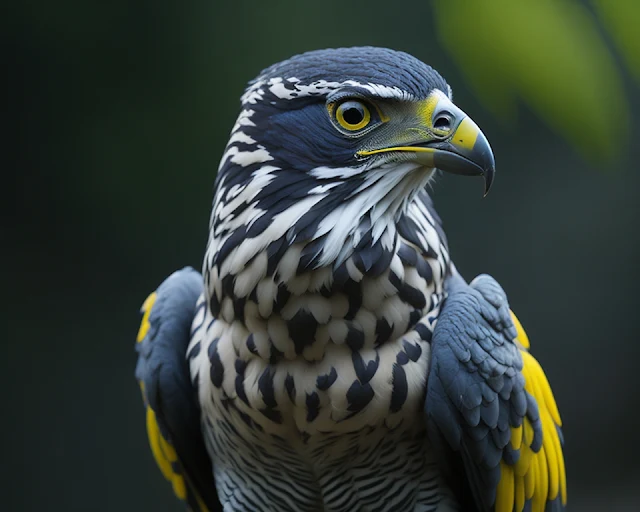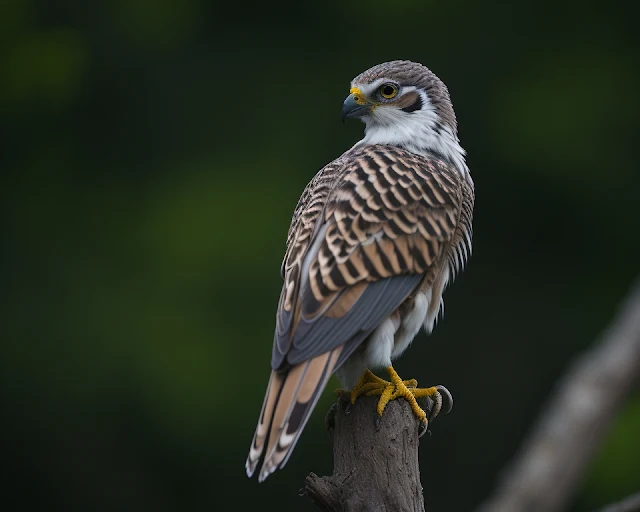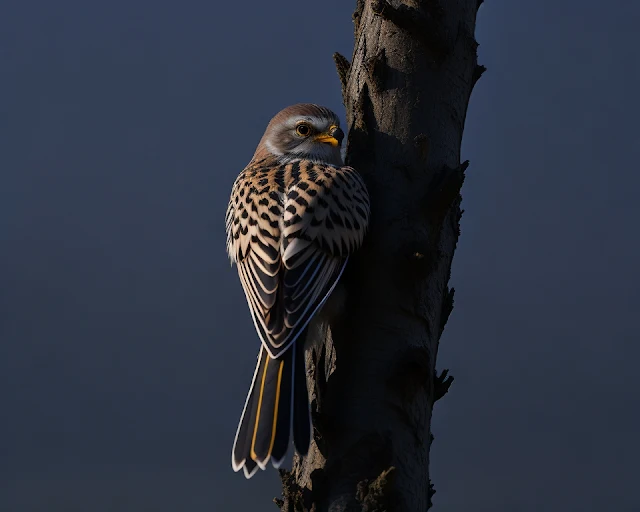How many speceis of Falcon? The part four
Falcon (4/5)
The pied falconet
The pied falconet is a small, colorful bird of prey that can be found in the forests and woodlands of Southeast Asia. It has been classified as near threatened by the IUCN due to its declining population numbers. This species is an important part of its local ecosystems, helping to keep insect populations in check while providing food for other animals such as snakes and birds.
The pied falconet measures just 18-20 cm in length and weighs only 35-50 grams making it one of the smallest raptors on Earth. Its plumage consists mainly of black feathers with white patches on either side giving it a distinctive “pied” appearance hence its name “Pied Falconet”. The head has yellow eyes with dark brown stripes running down from them towards the neck region which further enhances their striking looks.
In terms of diet, this species feeds mostly on insects like grasshoppers, beetles, or dragonflies which they capture using their sharp talons during flight. They also occasionally hunt small mammals such as rodents or bats but these are not common occurrences due to their size limitations when compared to larger predators like eagles or hawks who have no problem taking down bigger prey items if necessary.
Pairs will usually nest high up within trees where they lay 1–2 eggs per clutch before incubating them together until hatching takes place after around four weeks time period post-laying process completion.
The Malagasy Kestrel
The Malagasy kestrel (Falco newtoni) is an endangered species of raptor endemic to Madagascar. This small falcon, measuring approximately 30 cm in length, has a wingspan of up to 55 cm and weighs between 140-160 g. It is characterized by its dark brown upperparts with light spotting on the chest and belly, as well as its orange facial patch around the eyes that gives it a distinct appearance.
The Malagasy kestrel population has been steadily declining due to deforestation and habitat destruction caused by human activities such as logging or burning for agricultural purposes. Additionally, they are hunted for food in some areas which further contributes to their decline in numbers.
As such, conservation efforts have become increasingly important if this species is going to survive into the future; these include protecting remaining forests from human activities while also creating protected areas where hunting can be restricted or prohibited altogether so that this bird can continue living undisturbed within its natural habitat range without fear of persecution from humans.
In recent years more attention has been given towards preserving this unique creature through various initiatives including awareness campaigns about their plight among local communities near their habitats along with increased protection measures being implemented throughout Madagascar’s forests where they reside naturally .
With continued effort we may yet be able save them before it's too late - but only time will tell whether our actions today will make any difference tomorrow for these beautiful birds!
The Banded Kestrel
The Banded Kestrel is a small bird of prey native to Africa, the Middle East and parts of Asia. It is one of the most widespread raptors in its range, with an estimated global population in excess of 1 million individuals. The Banded Kestrel has a wingspan that ranges from 22-26 inches (56-66 cm) and typically weighs between 4-5 ounces (110-145 grams). Its plumage varies by region but generally consists mainly of dark brown or blackish upperparts with reddish underparts.
Banded Kestrels feed primarily on insects such as grasshoppers, beetles and locusts as well as small rodents like mice or shrews which they hunt from perches located high above ground level. They are also known to scavenge carrion when available for food sources during times when their preferred prey may be scarce due to seasonal fluctuations or other environmental conditions such as drought or prolonged cold weather events.
In addition to providing important ecological services through their role in controlling insect populations, Banded Kestrels are also popular among birdwatchers who enjoy observing these agile hunters soaring gracefully across open skies while searching for food items below them on land surfaces far below eye level where humans cannot easily observe them without specialized equipment like binoculars.
The Greater Kestrel
The Greater Kestrel (Falco rupicoloides) is a medium-sized bird of prey native to Africa, Eurasia and parts of the Middle East. It belongs to the falcon family and is one of the most widely distributed species in its genus. The species has adapted well to human disturbance and can be found in urban areas as well as rural ones, making it an important component of many ecosystems.
The Greater Kestrel typically prefers open habitats such as grassland, scrubland or savannah which provide ample opportunities for hunting small mammals like mice or voles.
They also feed on insects such as locusts when available but will take advantage of any food source they come across including carrion, garbage or even domestic birds if necessary! Unlike other raptors they are not particularly territorial so often roost communally with other kestrels during winter months when food becomes scarce.
These beautiful birds have long been admired by humans due their striking plumage; males feature bright orange head feathers while females tend towards browner tones with bold black markings around their eyes giving them a distinctive appearance that’s hard to miss!
With proper conservation efforts this unique bird should continue gracing our skies for years to come – we just need make sure that suitable habitat remains available for them wherever possible so future generations can enjoy these magnificent creatures too!
The Dickinson's Falcon
The Dickinson's Falcon is a medium-sized member of the Falconidae family and is gray in appearance. Keep in mind the bird's paleness, which is quite noticeable in flight, on its head, rump, and underwing. Its beak base and eye ring are also a brilliant yellow color.
Open savannas are where you may find the Dickinson's Falcon, and it favors places where there are baobabs and/or palm trees. It makes a krrrr sound that is repeated and vibrates. The paler head and underparts of the Dickinson's Falcon make it simple to differentiate it from the Slate Falcon. The underparts of the other tiny hawks are not gray.
Dickinson's falcons inhabit open places with perches and little vegetation, such as meadows and moderately forested regions. They can be found in regions with palm trees, doums, or other trees and are especially fond of plots of miombos (Brachystegia).
They like to spend a lot of time on their exposed perches in the winter while hiding in the vegetation during the breeding season. Dickinson's Falcons are also connected to scrubby woodland savannah.
The majority of the prey that Dickinson's Falcons pursue and catch on the ground or in the air are small vertebrates (such as rodents, lizards, tiny birds, and frogs) and invertebrates (such as crabs and insects). Some people are experts at capturing fruit bats.
Dickinson's falcon adult Semi-cavernicole nesting (broken, hole-filled trunk or branch, top of a dead palm). Old shadow nests and built objects like bridges are also employed. 2-4 cream-colored eggs with many crimson or dark brown patches and dots make up the clutch.
Like other raptors, only the female tends the brood. She carries the egg for around 30 days. The male provides for both his own needs and those of the brood. The chicks stay in the nest for 30 to 35 days.
The Grey Kestrel
The Grey Kestrel is a raptor of the falcon family that can be found throughout much of Africa, Asia and Europe. This majestic bird has a wingspan ranging from between 45 to 55 centimeters in length and weighs approximately 200 grams. It is mainly gray with black spots on its back, white patches on its chest and dark stripes across its face. Its long tail feathers are tipped with white which gives it an elegant appearance when soaring through the sky in search for prey.
The Grey Kestrel feeds primarily on small mammals such as rodents, lizards or insects but will also take advantage of any opportunity to scavenge carrion or feed off other birds’ kills if necessary.
They hunt by hovering over their target before diving down swiftly onto it at speeds reaching up to 100 kilometers per hour! After catching their meal they will either eat it right away or store some away for later consumption - this helps them survive during times when food may be scarce due to seasonal changes or other environmental factors affecting availability of prey items like drought conditions etc...
Grey Kestrels have proven themselves resilient against human activity such as deforestation; however they continue facing threats posed by hunting, trapping (for use in falconry) as well illegal trade amongst collectors who prize these birds for their beauty alone – all activities that must be stopped so we can ensure future generations get the chance enjoy watching this magnificent creature soar through our skies!
The Fox Kestrel
Fox Kestrels are a species of raptor found in many parts of the world. They have distinctive reddish-brown plumage and can reach lengths up to 15 inches long with wingspans measuring more than two feet wide. Fox Kestrels are known for their agility and speed, as they hunt during daylight hours by swooping down on small prey from high perches or while soaring through the air.
Fox Kestrels feed primarily on insects, but will also take small rodents, reptiles and birds if available. They typically inhabit open woodlands near water sources such as rivers or streams where there is plenty of food available for them to hunt. During breeding season they form monogamous pairs that build nests in trees or rocks crevices where eggs are laid and incubated until hatching takes place about three weeks later.
The conservation status of Fox Kestrel populations is generally considered stable across most regions although some localized declines have been observed due to loss of habitat caused by human activities such as logging operations or urban development projects which reduce suitable nesting sites for this species.
As a result , it’s important that we continue working together with local communities towards preserving natural habitats so these beautiful raptors can thrive along side us into future generations.
The Seychelles Kestrel
The Seychelles Kestrel (Falco araea) is an endangered species of bird endemic to the Seychelles islands in the Indian Ocean. It is one of only two kestrel species found on oceanic islands, and it has been listed as Critically Endangered by the IUCN since 1994 due to its small population size and limited range.
The main threats facing this beautiful raptor are habitat loss, predation by introduced mammals such as cats, rats and mongoose, competition with other birds for food resources, hunting pressure from local villagers for traditional ceremonies or medicinal practices and climate change which can affect their breeding success.
The Seychelles Kestrel was once widespread across all 115 granitic islands within its range but now it is confined mainly to three: Mahé Island where most individuals are found; Silhouette Island which holds about 20 pairs; Praslin Island with about 10-15 pairs remaining.
Conservation efforts have focused on preventing further declines in numbers through monitoring populations closely via surveys conducted annually at key sites throughout their range; controlling predators through trapping campaigns targeting cats around roosts during nesting season; providing supplementary feeding when necessary during times of low prey availability due to drought or disease outbreaks amongst natural prey items such as lizards or insects.
With restoring degraded habitats using native tree planting programmes that help provide suitable nesting sites for these birds while also increasing overall biodiversity levels within areas affected by deforestation activities caused by human development projects over recent decades .
Overall there has been some progress made towards conserving this unique species but if we want them around long term then more needs to be done quickly before they become extinct like so many other island endemics before them! We must continue our conservation efforts now so future generations will still be able see these magnificent creatures living freely in their natural environment instead of just reading about them from books written centuries ago!
The Common Kestrel
The Common Kestrel is a small bird of prey that can be found in many places around the world. It has long been admired for its beauty and agility, as well as its ability to hunt successfully in a wide range of habitats. The kestrel is an important species to consider when discussing conservation efforts, due to their declining population numbers over recent years.
Common Kestrels are easily recognizable by their distinctive brown-and-black striped wings and tail feathers with lighter colored upperparts and white patches on the face near the eyes. They have strong feet which allow them to grip onto branches while they search for food or take flight after catching it's prey; typically consisting of small rodents, insects or other birds that they spot from high above while flying at speeds up to 40 miles per hour!
Their unique hunting style involves hovering high above open fields before diving down quickly towards potential targets below them - this technique allows them greater accuracy when targeting smaller creatures than most other birds could achieve without such effortless maneuverability in midair!
Conservation efforts must remain focused on preserving suitable habitat areas for these beautiful raptors so that future generations may continue enjoying their presence amongst us all into perpetuity – especially given current threats posed by human activity such as deforestation, climate change and urban development encroaching upon traditional nesting grounds used by these magnificent creatures throughout history since time immemorial!
With increased awareness about this species' plight comes more concerted action taken toward protecting our natural environment where possible – thus ensuring continued survival rates among wild populations everywhere across our planet earth now and forevermore!.
The Lesser Kestrel
Particularly in female and young plumage, Kestrel is sometimes mistaken for it. Male adult with unblemished, gray cheeks, no moustache-strip, and no crown streaking. Greater coverts on the upper wing are gray, standing out against the brick red forewing and back without any black marks. Belly spots are few. Less barring on the underside of the wings than on the Kestrel, and more noticeable black wing tips and trailing edges.
Additionally, this is somewhat discernible in females and young birds. Because their face markings are more subdued, female and juvenile birds have a less severe appearance than Kestrels. Mask does not cover the back of the eye. Tail significantly shorter than a Kestrel, with center feathers that are frequently slightly extended (uncommon in Kestrels). Not black, but pale, talons.
Shallow wingbeats and light, quick flight. Hovers less than the Kestrel yet soars higher in the upwind. It takes a mix of plumage, structural, and behavioral (flight movement) features to identify female/immature birds.
The Lesser Kestrel inhabits a large area of Asia, northern Africa, and portions of Europe.It lives largely in open spaces like semidesert, steppe landscapes, meadows, and even agricultural fields throughout its vast range. It steers clear of thick wooded areas.
The Lesser Kestrel is an expert insect hunter, just like many other kestrels, and it often catches large insects including grasshoppers, crickets, and beetles. It will also occasionally eat fish, crabs, earthworms, rodents, birds, and reptiles! When looking for food, it uses a variety of hunting strategies.
Small colonies of 10 to 20 breeding pairs comprise this species of falcon. They don't build their own nests as other falcons do; instead, they lay their eggs in cliff crevices, ancient churches, barns, or other structures, sometimes even in abandoned bird nests or nest boxes. Additionally, it may be observed breeding in "mixed-species" colonies, which are groups of nesting birds from other bird species.









